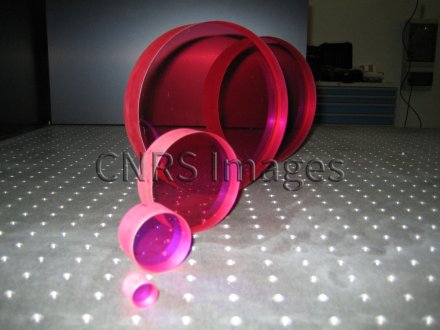Production year
2010

© Gilles CHERIAUX/LULI/CNRS Images
20160098_0002
Cristaux de saphir dopés au titane (TiSa), avant leur intégration dans les dispositifs optiques du laser Apollon. Ils mesurent 15 à 175 mm de diamètre. Ils formeront cinq étages d'amplification, grâce auxquels le laser passera de 10 millijoules à 330 joules. Chaque étage sera pompé par des lasers verts (527 nanomètres). Opérationnel en 2018, le laser Apollon atteindra 5 pétawatts. Il permettra d'explorer de nouveaux pans de la physique, notamment la physique relativiste, c'est-à-dire le fonctionnement de la matière lorsque les particules se déplacent à une vitesse proche de celle de la lumière.
The use of media visible on the CNRS Images Platform can be granted on request. Any reproduction or representation is forbidden without prior authorization from CNRS Images (except for resources under Creative Commons license).
No modification of an image may be made without the prior consent of CNRS Images.
No use of an image for advertising purposes or distribution to a third party may be made without the prior agreement of CNRS Images.
For more information, please consult our general conditions
2010
Our work is guided by the way scientists question the world around them and we translate their research into images to help people to understand the world better and to awaken their curiosity and wonderment.